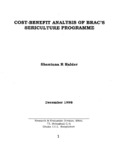Cost-benefit analysis of BRAC's sericulture programme
Citation
Halder, S. R. (1998, December). Cost-benefit analysis of BRAC’s sericulture programme. Research Reports (1998): Economic Studies, Vol - XIII, 1–50.Abstract
The Sericulture Programme of BRAC is one of the most ambitious among BRAC sector
programmes. Since 1992 BRAe has gone through a large scale expansion of the plantation
programme. Major components of the programme are: a) nursery, b) mulberry plantation, c)
rearing of the silkworms, d) reeling, and e) weaving.
The main objective of the study was to measure the efficiency of the programme by doing a cost
benefit analysis from the participants' as well as the organizers' point of view. The specific
objectives of the study were: 1) to determine employment created by BRAC to measure the
opportunity cost of time and BRAC's achievements in this area; 2) to determine the programme
costs and returns for calculating the profitability of the different components of the programme;
3) to calculate accounting and economic profit to determine the viability of programme
participants; and 4) to identify the socia-economic constraints on programme sustainability. The study considered four different stages of measuring programme viability. In the first stage
the employment generation in each component of the programme was detennined to calculate the
minimum opportunity cost of time and BRAC's achievements. In the second stage both
programme input and output records were used to calculate the total cost of the programme and
the revenue it earned. Major components of fixed and variable costs may differ in different
programme activities which were also considered. In the third stage participants viability was
investigated. Indicators used to measure participants viability were: 1) profit per unit of input; 2)
average rate of return on investment =profit/total investment on fixed assets; 3) average rate of
return on operating cost =profit/operating cost; 4) yield or value of output per unit of major
input; and 5) amount or cost of input per unit of output. The programme is treated as
economically viable when the actual rate of return exceeds the market rate of interest.
The fourth stage described the programme viability. Monthly receipts and expenditure statements
of sericulture programme were used to evaluate it. The study tried to focus on how to increase
the physical output to its maximum level and to reduce costs to its minimum.
Primary data were collected from a random sample of 492 programme participants from 10 AOs
including 26 sapling growers and 300 silk worm rearers. Due to the fact that reeling, pedal
spinning and weaving were not done in every selected AOs, fifty seven workers from three
reeling centres, 64 pedal spinners from five AOs and 45 weavers from three BRAe weaving
programme areas were selected.

